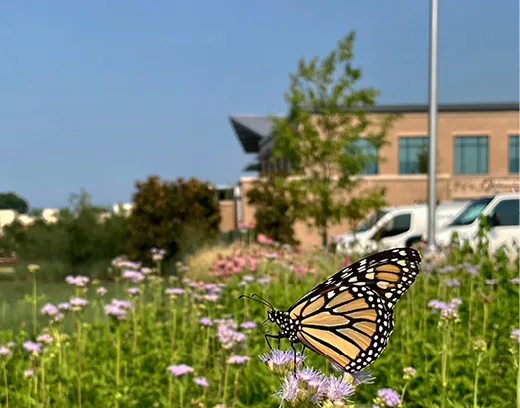
By J.G. Domke, Fort Worth Chapter
Good news: interest in and respect for native plants has been growing in the town of Flower Mound, just north of Grapevine in Denton County. Founded in 1961, the town’s master plan states they are committed to “preserve the country atmosphere and natural environment.”
After a hard freeze in February 2021, all of the non-native plants in the town’s 3600 square-foot pollinator garden at Town Hall died. But the native plants survived. Environmental Programs Coordinator and North Central Chapter member Tyler Leverenz recalls how surprised residents and Town Council members were when they realized how much better the native plants had fared. “I’ve found a lot of people don’t know the difference between native and introduced species or even invasive plants. They don’t know why you want to plant one versus another,” she said. “With our focus on the country heritage (in Flower Mound), we feel residents care about the environment.”
The acceptance of native plants continues to grow. Last October, the Environmental Services Department removed 400 square feet of turf and further expanded the pollinator garden, thanks to a grant from the Native Plant Society of Texas Trinity Forks Chapter. A variety of native plants were planted including Texas Frogfruit (Phyla nodiflora), Henry Duelberg Sage (Salvia farinacea), Texas Lantana (Lantana horrida syn. L. urticoides), and Purple Coneflower (Echinacea purpurea), according to Tyler.
Native plants were also planted in 1800 square feet of pollinator garden in Flower Mound’s new Town Arboretum, which is a joint project led by Environmental Services with support from the Parks Department. Officials plan to apply to become accredited in the Morton Registry of Arboreta this year.
Tyler has a strong commitment to educating the public on environmental issues, including the benefits of using native plants in the landscape. In 2022 she launched an Environmental Speaker Series at the Flower Mound Public Library. The lectures have been so well received by the community that three sessions are now being held every spring and fall. A class on how to create a Monarch Garden that was presented by the Monarch Watch committee was also particularly well attended.
By continuing to educate the public about the benefits of native plants, Tyler hopes to motivate residents to volunteer to help maintain the new gardens–and continue to build on the momentum they have already established. “We just need to educate people, and that’s what we’re trying to do,” she said. For more information, visit www.flower-mound.com/2099/Gardening-for-Nature.
Did you like this article? It’s from our Winter 2024 Texas Native Plants magazine. Read more here



